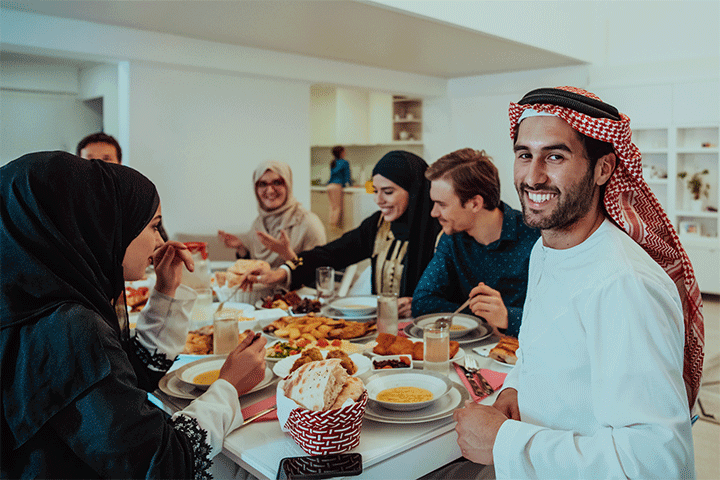If you’re looking to learn the Arabic language, you’re about to embark on an incredible journey! This language isn’t just a collection of words; it’s a gateway to a world rich in history, traditions, and values. To truly understand the language, it’s essential to immerse yourself in Arabic culture. This article is your detailed guide to exploring this fascinating culture and its most important aspects.
What is Arabic Culture?
Arabic culture is a complex tapestry that spans over 22 countries, from the Atlantic Ocean to the Arabian Gulf. Despite the great diversity in dialects and local customs, there are shared values that unite these peoples. It is a culture built on generosity, strong family ties, and mutual respect.
The Core Pillars of Arabic Culture
Understanding these pillars is key to understanding any Arab society.
Arab Hospitality
Arab culture is famous for its hospitality. Welcoming a guest is considered a great honor, and a common saying is, “The guest is a guest of God.” This tradition is more than just a custom; it’s a fundamental part of the identity.
- Serving Coffee and Tea: As soon as you arrive, they will likely offer you Arabic coffee or tea. This is an integral part of the welcome.
- Abundant Food: The host will often serve you the best food in the house. Don’t hesitate to praise the food, as it makes the host happy.
- Home Visit Etiquette: When visiting a home, wait until the host asks you to sit. Take off your shoes if you see the host doing so. And never refuse the offer of coffee or tea, as this can be considered an insult.
Family and Community
The family is the nucleus of Arab society. Family bonds are extremely strong, and grandparents, aunts, and uncles often live near each other.
- Respect for Elders: Respecting parents, grandparents, and older individuals is one of the most important Arab customs. Their advice is taken seriously, and they are often at the center of important decisions.
- Social Solidarity: In Arab communities, relatives and neighbors help each other in times of hardship. People don’t hesitate to offer assistance when needed, which strengthens the sense of community.
Religion and Values
Islam is the predominant religion in the Arab world and plays an important role in shaping Arabic customs and traditions.
- The Role of the Mosque: The mosque is not just a place for prayer; it’s also a community center where people meet and connect.
- Religious Holidays: Eid al-Fitr and Eid al-Adha are two important occasions for celebration and family gatherings. During these times, children learn the value of giving and helping those in need.
- Ethical Values: The culture deeply roots and encourages values like honesty, integrity, and justice in all aspects of life.
Language and Communication
The Arabic language is the beating heart of Arabic culture. Understanding some linguistic aspects can completely transform your experience.
- Warm Greetings: Greetings in the Arab world are not just words; they are a way to build a relationship. When you meet someone, you will often be asked about their well-being and their family.
- Using Titles: People use titles like ‘ustaath’ (teacher) or ‘doctor’ to show respect. They might also call an older person ‘uncle’ or ‘aunt,’ even if they’re not a relative.”
- The Role of Poetry and Proverbs: Poetry is a fundamental part of Arab heritage. People frequently use proverbs and popular sayings in daily conversation to convey wisdom or advice.
Art and Entertainment
Arabic culture is rich in art forms that reflect the region’s beauty and history.
- Music: Arabic music is diverse, ranging from classical traditional music to modern tunes. Songs often tell stories about love, home, or life.
- Arabic Calligraphy: Calligraphy is not just writing; it’s an art form in itself. It is considered one of the beautiful Islamic arts that adorn mosques, books, and homes.
- Folk Tales: Stories like “One Thousand and One Nights” are part of Arab traditions, showing the rich imagination and power of storytelling.
Arabic Culture vs. Middle Eastern Culture
The term Middle Eastern culture is sometimes used to describe the region, but it’s not exactly a synonym for Arabic culture. The Middle East includes non-Arab countries (like Turkey and Iran). Arabic culture is a major and essential part of Middle Eastern culture, but it’s not the entire picture.
Conclusion
Understanding Arabic culture is a wonderful adventure that will make your journey to learning the language more enjoyable and effective. You’ll discover that behind every word and grammatical rule, there is a rich history and warm customs that connect people. Download the Kaleela app and start your journey today!



